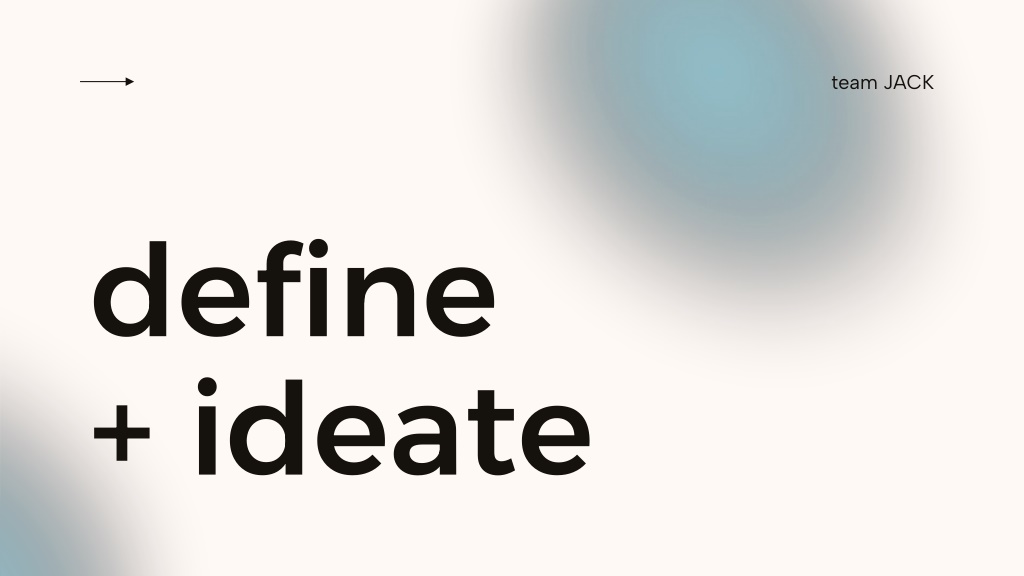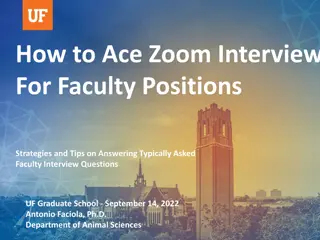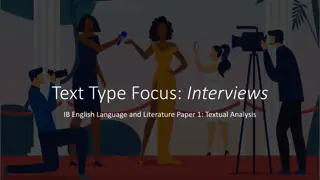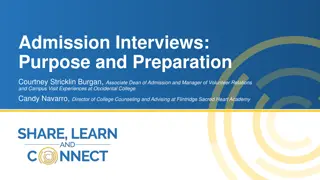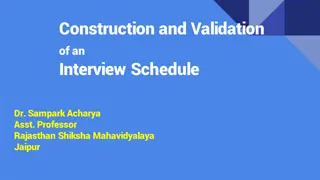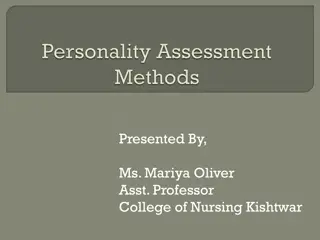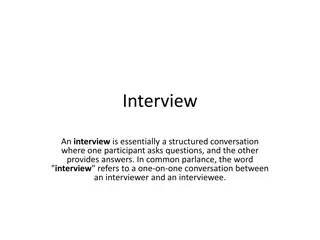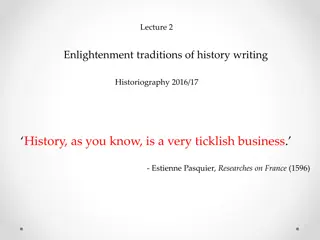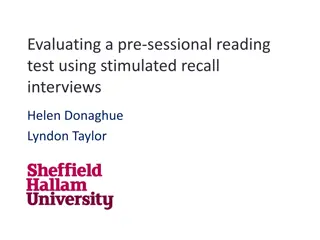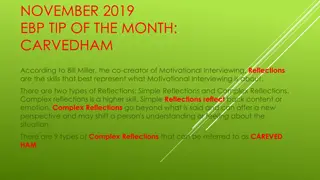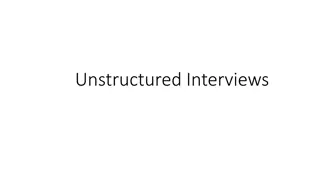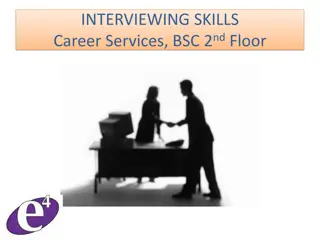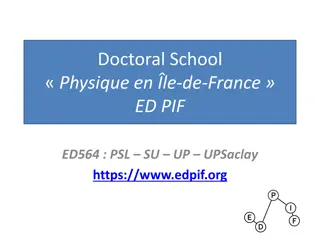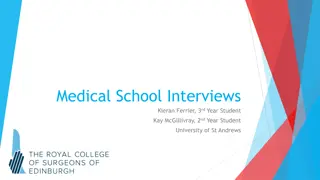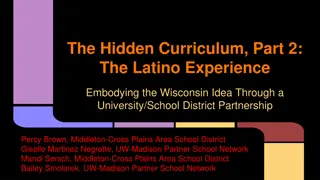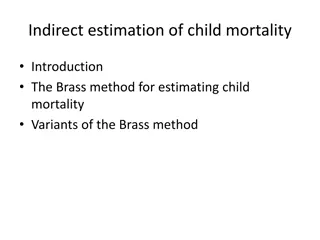Exploring Personal Histories Through Interviews and Reflections
In this narrative, we delve into the stories of individuals from Team JACK, the team Kabir, Caleb, Jasmine, and Alyssa, as well as additional interviews with Akshay and Taylor. The discussions touch upon capturing personal histories, sharing moments, and reflections on familial legacies. Discover how individuals like Akshay use traditional methods like cooking to connect with their heritage, while Taylor finds meaning in physical objects as reminders of cherished memories. Through these interviews, we explore themes of family relationships, cultural preservation, and personal growth.
Download Presentation

Please find below an Image/Link to download the presentation.
The content on the website is provided AS IS for your information and personal use only. It may not be sold, licensed, or shared on other websites without obtaining consent from the author. Download presentation by click this link. If you encounter any issues during the download, it is possible that the publisher has removed the file from their server.
E N D
Presentation Transcript
team JACK define + ideate
the team Kabir Caleb Jasmine Alyssa computer science cs, music psychology, cs product design, cs
original domain capturing personal history focused domain capturing and sharing personal moments
here we go again 01 interviews
additional interviews Akshay Jaggi Taylor Pope Student at Harvard Medical School late twenties Boston, MA via zoom found from Stanford Time Capsule Software engineer for a startup mid forties Redwood City, CA @ Town and Country found on r/redwoodcity * AI generated image
Akshay medical student late twenties Using the 40 year old stovetop pressure cooker to recreate my grandmother s recipes brings me closer to her, especially since she s too frail to make them herself now
takeaways from Akshays interview records grandparents stories on his phone to capture them in an unobtrusive way, but still notices his grandparents discomfort from being recorded motivated to capture stories or recipes by a strong feeling or impulse sense of spontaneity stark contrast between parent/child relationship vs. grandparent/grandchild relationship as future generations continue in the US, there needs to be a way to breach the widening gap in language and religion barriers to retain rich parts of family history
Taylor software engineer based out of Redwood City To me, the physical objects represent a holistic aggregation of the smaller moments
takeaways from Taylors interview physical objects, like a wood carving or 3D rendering of a rock from her grandparents backyard, prompt reflection for Taylor and represent a collection of memories and feelings has diligently journaled every day for the past 15 years but rarely looks back on her entries when prompted to reflect on how her past has informed her present, she feels like she is in pursuit of a constant quest to set her future self up for success but only recently started reaping the benefits feels like she is hoarding but can t figure out which saved items are junk and which possess lasting value
does preservation projects for her family laser print on slice of tree branch from the tree in her grandparents yard grandparents are depicted underneath the tree from which the branch was cut physical mementos
initial POV: Asher We met Asher, a Stanford student and aspiring physician. We were surprised to realize he no longer wants to continue his family heirloom tradition with his watch. We wonder if this means physical heirlooms hinder some family members from connecting with strengthening connections between others. It would be game-changing to help him create shared heirlooms.
POV #1: Asher (A) We met Asher, a Stanford student and aspiring physician who cultivates connections to his family history through heirlooms and stories from immigrant grandparents. how might we ruminate on sad moments for longer to lead to greater mental well-being? 01 We were surprised to hear that whenever he feels sad, he sets phone reminders containing memories that make him smile for random points in the near future to cheer his future self up. 02 figure out the appropriate moments for providing a positive reminder? We wonder if Asher believes he is the most effective person at improving his own mental well being. 03 include loved ones in our own journey to deal with negative emotions? It would be game-changing to provide a way to detect patterns in the types of memories that have the strongest impact on helping him overcome negative emotions.
POV #2: Asher (B) We met Asher, a Stanford student and aspiring physician who cultivates connections to his family history through heirlooms and stories from immigrant grandparents. how might we duplicate a family heirloom so that others in the family can also have it? 01 We were surprised to hear that Asher no longer wants to continue his family s tradition of passing down a watch heirloom ot the oldest son. 02 ensure future generations continue supporting family traditions after we pass? We wonder if Asher doesn t feel personally connected to the history and significance of the watch, and, as a result, doesn t feel motivated to continue the tradition. 03 crowdsource family history? It would be game-changing to find a way for Asher to better connect stories from his relatives and ancestors to the family heirlooms in his possession.
POV #3 Michael We met Michael, Austin resident and avid photographer and journaler. how might we We were surprised to find out that Michael frequently revisits his own journal entries as a source of motivation but keeps all the entries on one Notes app document without a meaningful method of organization. take the effort out of organization (for journal entries and photos)? 01 02 record which journal entries Michael goes back to the most? We wonder if capturing memories and thoughts is done on an impulse or strong feeling without forward- thinking, resulting in disorganized record-keeping. 03 use the act of organizing after the fact to reflect? It would be game-changing to create a way for Michael to capture impulsive thoughts and memories in an organized way without detracting from the spontaneity of the act.
top 3 HMWs and their POVs 03 HMWs
HMW #1 We met Asher, a Stanford student and aspiring physician who cultivates connections to his family history through heirlooms and stories from immigrant grandparents. We were surprised to hear that whenever he feels sad, he sets phone reminders containing memories that make him smile for random points in the near future to cheer his future self up. How might we include loved ones in our own journey to deal with negative emotions? We wonder if Asher believes he is the most effective person at improving his own mental well being. It would be game-changing to provide a way to detect patterns in the types of memories that have the strongest impact on helping him overcome negative emotions.
HMW #2 We met Michael, Austin resident and avid photographer and journaler. We were surprised to find out that Michael frequently revisits his own journal entries as a source of motivation but keeps all the entries on one Notes app document without a meaningful method of organization. How might we take the effort out of organization? We wonder if capturing memories and thoughts is done on an impulse or strong feeling without forward- thinking, resulting in disorganized record-keeping. It would be game-changing to create a way for Michael to capture impulsive thoughts and memories in an organized way without detracting from the spontaneity of the act.
HMW #3 We met Michael, Austin resident and avid photographer and journaler. We were surprised to find out that Michael frequently revisits his own journal entries as a source of motivation but keeps all the entries on one Notes app document without a meaningful method of organization. How might we record which journal entries Michael goes back to the most? We wonder if capturing memories and thoughts is done on an impulse or strong feeling without forward- thinking, resulting in disorganized record-keeping. It would be game-changing to create a way for Michael to capture impulsive thoughts and memories in an organized way without detracting from the spontaneity of the act.
3 solutions we are moving forward with 04 solutions
top 3 solutions musically driven entries virtual time capsule journal tagging Support searching through journal entries by tagging each one by location, emotion, and people. Add songs to journal entries to be able to categorize based on feelings and emotions. Create a digital vault where loved ones can send messages, videos, or pictures to be opened in the future.
critical assumptions we are testing with our experience prototypes 05 prototypes
1: journal tagging solution Support searching through journal entries by tagging each one by location, emotion, and people. assumption When people look back at their entries, they are intentionally looking for ones of certain emotions, locations, or people.
experience prototype phase 1: journaling Have participant journal adhering as close as possible to their usual process for 10 minutes in their preferred medium. phase 2: reflection Upon completion, engage in dialogue to identify the prominent emotions or themes of the entry, and more broadly explore the ways they introspect upon their previous entries.
Dalynn has journaled habitually since she was 15. She enjoys singing, songwriting, and design.
key insight Only writes in journal during turbulent times. Thus, looking back is sometimes detrimental to well-being. Wrote about a couple notable people during the day, and titled the entry as feeling hopeful!!! Would love to see memories with loved ones, but looking at memories no longer applicable to your life may be damaging to the peace Things she cared about in the past are a lot different than now. Journaling is primary a way for her to figure where she is. It s more about the act of doing it then the product created from it.
2: musically driven entries solution Add songs to journal entries to be able to categorize based on feelings and emotions. assumption Music and it s associative power allows people to capture their thoughts in a way that words or pictures cannot.
experience prototype phase 1: photo selection Have participant choose 10-15 photos from their past. No further instructions given ensuring the choices remain genuine and uninfluenced phase 2: scoring it Have participating choose a piece of music that encapsulates the photos as a collection. phase 3: reflection Engage in dialogue aiming to delve deeper into their perceptions and their influence on their retrospection and connection to past memories
key insight Music can bring you back to certain emotions and associated memories. I ve recently been stimulating myself with positive music to keep me up high Listened to a lot of sad music in the past, but realized it would often negatively affect her mood. Believes music is at its core very emotional, and it s impossible to have an emotionless song. It s a way humans can communicate emotionally in a more cryptic, less vulnerable way. Maps both music to memories and memories to music.
Jeannie is a healthcare professional in her 60s with photographic memory. key insight Uses music to mark the transitions in her day to day life. Music and nature are her driving forces. Takes screenshots of songs at the parts that really hit home for her to look back on. Uses music to emotionally regulate and believes this is really healthy for her.
3: virtual time capsule solution Create a digital vault where loved ones can send messages, videos, or pictures to be opened in the future. assumption Receiving premeditated surprises from the past gives a boost in one s mental well-being.
experience prototype phase 1: surprise! Coordinate with family member/friend to send a picture with a message to the unknowing participant. phase 2: reflection Engage in dialogue to understand the emotional response to the surprise.
additional interviews Thomas Luc Upbringing heavily emphasizes relationship with family and loved ones. Has long distance girlfriend, which makes digital communication very important to him.
key insight Despite valuing connectivity with loved ones, unexpected interactions evoke uneasiness because they are a deviation from regular communication patterns. Doesn t usually receive surprise messages, so felt like something was up. Generally, I don t expect loved ones to reach out so it s nice when they surprise you. Texted his brother to check in after not texting him for a while and received a ? as a response. picture sent by Katie (close friend)
key insight Surprises make you feel nice, but life is perfectly fine without them. It can be harmful to expect people to surprise you. Questioned the genuinity of the act. Thought that the friend had other intentions than wanting to make him feel good. Doesn t feel that much closer to the person after receiving the text. It may have been more effective if the surprise required more effort than sending a text message. Values relationships very highly but thinks that surprise text messages are not necessary to maintain them. picture sent in by Emma (close friend)
SUMMARY Reflection isn t necessarily healthy for mental well-being. Music, emotion, and memories are tightly linked. Some journal for introspection rather than to have an end product. Surprises can be cause for suspicion if they don t happen that often People anchor memories to certain people, locations, or emotions.
our solution moving forward 06 next up
Those who journal digitally tend to look reflect and look back on their entries.
moving forward with musically driven entries Music correlates heavily to people s moods. It is an additive to journaling and reflection, rather than a substitute for anything.
HMW + solutions brainstorming 07 appendix
